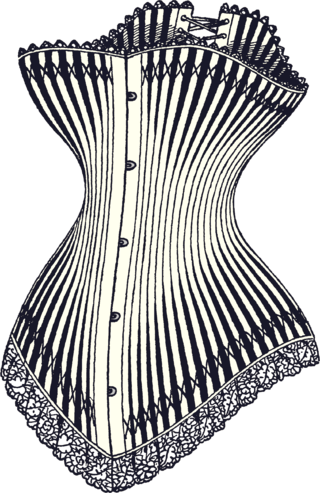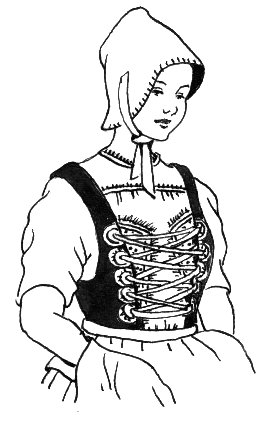
Fashion is a term used interchangeably to describe the creation of clothing, footwear, accessories, cosmetics, and jewellery of different cultural aesthetics and their mix and match into outfits that depict distinctive ways of dressing as signifiers of social status, self-expression, and group belonging. As a multifaceted term, fashion describes an industry, styles, aesthetics, and trends.

Gothic fashion is a clothing style worn by members of the goth subculture. A dark, sometimes morbid, fashion and style of dress, typical gothic fashion includes black dyed hair and black clothes. Both male and female goths can wear dark eyeliner, dark nail polish and lipstick, and dramatic makeup. Styles are often borrowed from the Elizabethans and Victorians. BDSM imagery and paraphernalia are also common. Gothic fashion is sometimes confused with heavy metal fashion and emo fashion.

A corset is a support garment worn to hold and train the torso into the desired shape and posture. They are traditionally constructed out of fabric with boning made of whalebone or steel, a stiff panel in the front called a busk which holds the torso rigidly upright, and some form of lacing which allows the garment to be tightened. Corsets were an essential undergarment in European women's fashion from the 17th century to the early 20th century. In the 17th and 18th centuries they were commonly known as "stays" and had a more conical shape. This later evolved into the curvaceous 19th century form which is commonly associated with the corset today. By the beginning of the 20th century, shifting gender roles and the onsets of World War I and II led the corset to be largely discarded by mainstream fashion.

The Fashion Institute of Technology (FIT) is a public college under the State University of New York, in New York City. It focuses on art, business, design, mass communication, and technology connected to the fashion industry. It was founded in 1944.

Elsa Schiaparelli was an Italian fashion designer from an aristocratic background. She created the house of Schiaparelli in Paris in 1927, which she managed from the 1930s to the 1950s. Starting with knitwear, Schiaparelli's designs celebrated Surrealism and eccentric fashions. Her collections were famous for unconventional and artistic themes like the human body, insects, or trompe-l'œil, and for the use of bright colors like her "shocking pink".
A rivethead or rivet head is a person associated with the industrial dance music scene. In stark contrast to the original industrial culture, whose performers and heterogeneous audience were sometimes referred to as "industrialists", the rivethead scene is a coherent youth culture closely linked to a discernible fashion style. The scene emerged in the late 1980s on the basis of electro-industrial, EBM, and industrial rock music. The associated dress style draws on military fashion and punk aesthetics with hints of fetish wear, mainly inspired by the scene's musical protagonists.

A bodice is an article of clothing traditionally for women and girls, covering the torso from the neck to the waist. The term typically refers to a specific type of upper garment common in Europe during the 16th to the 18th century, or to the upper portion of a modern dress to distinguish it from the skirt and sleeves. The name bodice is etymologically an odd plural spelling of "body" and comes from an older garment called a pair of bodies.

Dame Zandra Lindsey Rhodes, is an English fashion and textile designer. Her early education in fashion set the foundation for a career in the industry creating textile prints. Rhodes has designed garments for Diana, Princess of Wales and numerous celebrities such as rock stars Freddie Mercury and Marc Bolan. She has also designed textiles for interiors, featuring her prints on furniture and homewares. In 2003 Rhodes founded the Fashion and Textile Museum in London.

A shrug is a cropped, cardigan-like garment with short or long sleeves cut in one with the body, typically knitted or crocheted. Generally, a shrug covers less of the body than a vest would, but it is more tailored than a shawl. Shrugs are typically worn as the outermost layer of an outfit, with a full shirt, tank top, or dress beneath.

Valerie Fahnestock Steele is an American fashion historian, curator, and director of the Museum at the Fashion Institute of Technology. Steele has written more than eight books on the history of fashion, and can be regarded as one of the pioneers in the study of fashion. She was appointed director of the museum in 2003.

Suzy Peta Menkes is a British journalist and fashion critic. Formerly the fashion editor for the International Herald Tribune, Menkes also served as editor, Vogue International, for 25 international editions of Vogue online until October 2020.
Science fiction studies is the common name for the academic discipline that studies and researches the history, culture, and works of science fiction and, more broadly, speculative fiction.

Fashion in the period 1900–1909 in the Western world continued the severe, long and elegant lines of the late 1890s. Tall, stiff collars characterize the period, as do women's broad hats and full "Gibson Girl" hairstyles. A new, columnar silhouette introduced by the couturiers of Paris late in the decade signaled the approaching abandonment of the corset as an indispensable garment.
Born in the second half of the 1970s and developed in the 1980s, power dressing is a fashion style that enables women to establish their authority in a professional and political environment traditionally dominated by men.

A dress is a one-piece outer garment that is worn on the torso and hangs down over the legs and is primarily worn by women or girls. Dresses often consist of a bodice attached to a skirt.
A strapless dress or top is a garment that stays put around the upper body without shoulder straps or other visible means of support. It is usually supported by an internal corset and/or brassiere, with the tightness of the bodice preventing the dress from slipping out of position.
Vestoj is an annual academic journal about dress and fashion. The editor-in-chief and publisher is Anja Aronowsky Cronberg.
Charles Jon Brainerd is an American psychologist and professor in the College of Human Ecology at Cornell University. He is known for developing fuzzy-trace theory with his wife and colleague, Valerie F. Reyna. He serves as editor-in-chief of the peer-reviewed scientific journal Developmental Review.

Dress history is the study of history, which uses clothing and textiles to understand the past. Through analyzing modes of dress, different garment types, textiles, and accessories of a certain time in history, a dress historian may research and identify the social, cultural, economic, technological, and political contexts that influence such phenomena and experiences of living during the period under investigation.

Ekaterina Vasileva is a Russian art critic, specialist in the history and theory of photography,fashion, design and contemporary art. Candidate of Sciences, Associate Professor at Saint Petersburg State University. Member of the Union of Artists of Russia, member of the Union of Photographers of Russia, member of the International Association of Art Critics, member of the Union of Journalists of Russia. The works of Ekaterina Vasilyeva are in the collections of the largest Russian libraries, as well as in the collections of the Library of Congress (Washington), the Warburg Library (London), the Cini Foundation Library (Venice), etc.













